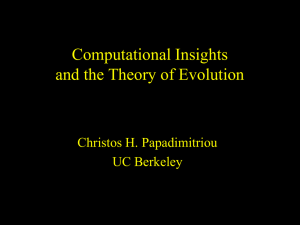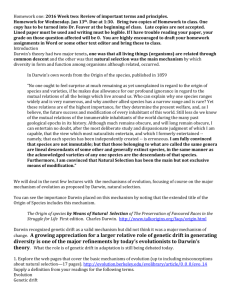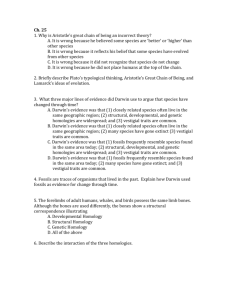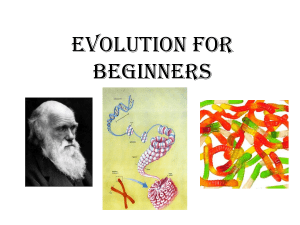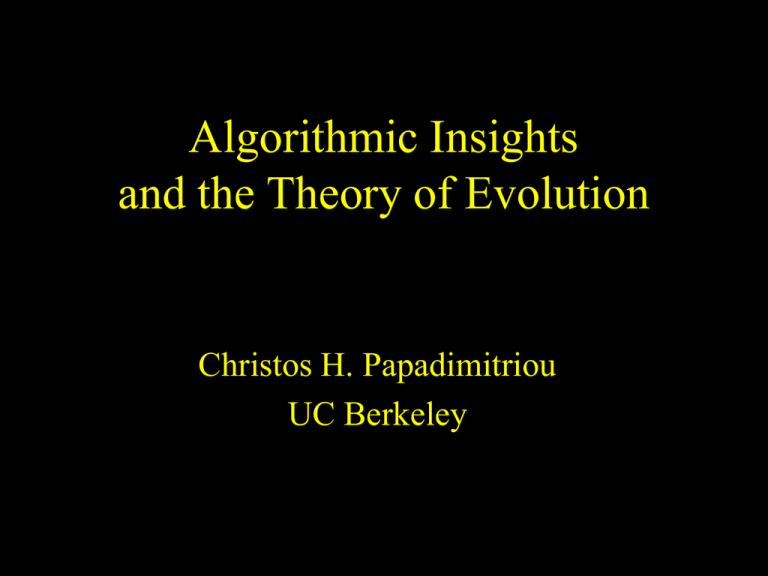
Algorithmic Insights
and the Theory of Evolution
Christos H. Papadimitriou
UC Berkeley
The Algorithm as a Lens
• It started with Alan Turing, 60 years ago
• Algorithmic thinking as a novel and
productive way for understanding and
transforming the Sciences
• Mathematics, Statistical Physics, Quantum
Physics, Economics and Social Sciences…
• This talk: Evolution
Evolution Before Darwin
• Erasmus Darwin
Before Darwin
• J.-B. Lamarck
Before Darwin
• Charles Babbage
[Paraphrased]
“God created not species, but the Algorithm
for creating species”
Darwin, 1858
• Common Ancestry
• Natural Selection
The Origin of Species
• Possibly the world’s most
masterfully compelling scientific
argument
• The six editions 1859, 1860,
1861, 1866, 1869, 1872
The Wallace-Darwin papers
Brilliant argument, and yet many
questions left unasked, e.g.:
• How does novelty arise?
• What is the role of sex?
After Darwin
• A. Weismann
[Paraphrased]
“The mapping from genotype to phenotype is
one-way”
Genetics
• Gregor Mendel [1866]
• Number of citations
between 1866 and 1901:
3
The crisis in Evolution
1900 - 1920
• Mendelians vs. Darwinians
• Geneticists vs.
Biometricists/Gradualists
The “Modern Synthesis”
1920 - 1950
Fisher – Wright - Haldane
Big questions remain
e.g.:
• How does novelty arise?
• What is the role of sex?
Evolution and
Algorithmic Insights
•
“ How do you find a 3-billion
long string in 3 billion years?”
L. G.Valiant
At the Wistar conference (1967), Schutzenberger
asked virtually the same question
Valiant’s Theory of Evolvability
• Which traits can evolve?
• Evolvability is a special case of statistical
learning
Evolution and CS Practice:
Genetic Algorithms [ca. 1980s]
• To solve an optimization problem…
• …create a population of solutions/genotypes
• …who procreate through sex/genotype
recombination…
• …with success proportional to their objective
function value
• Eventually, some very good solutions are
bound to arise in the soup…
And in this Corner…
Simulated Annealing
• Inspired by asexual reproduction
• Mutations are adopted with probability
increasing with fitness/objective differential
• …(and decreasing with time)
The Mystery of Sex Deepens
• Simulated annealing (asexual reproduction)
works fine
• Genetic algorithms (sexual reproduction)
don’t work
• In Nature, the opposite happens: Sex is
successful and ubiquitous
?
A Radical Thought
• What if sex is a mediocre optimizer of
fitness (= expectation of offspring)?
• What if sex optimizes something else?
• And what if this something else is its
raison d’ être?
Mixability!
• In [LPDF 2008] we establish through
simulations that:
• Natural selection under asex optimizes
fitness
• But under sex it optimizes mixability:
• The ability of alleles (gene variants) to
perform well with a broad spectrum of other
alleles
Explaining Mixability
• Fitness landscape of a 2-gene organism
Rows: alleles
of gene A
3
1
2
0
2
1
1
8
3
1
2
2
0
1
1
8
3
2
4
5
4
1
0
0
7
2
0
4
3
1
3
2
4
0
20
1
14
5
7
4
2
4
3
3
2
1
8
0
0
5
7
4
4
2
3
1
3
2
Columns: alleles of gene B
Entries: fitness
of the combination
Explaining Mixability (cont)
• Asex will select the largest numbers
3
2
3
1
1
2
0
2
4
4
0
5
7
0
4
2
1
0
4
3
1
2
8
1
3
0
2
3
1
2
1
2
0
1
4
0
0
5
7
4
1
4
2
3
1
8
1
3
2
0
1
8
5
4
7
2
4
3
3
2
Explaining Mixability (cont)
• But sex will select the rows and columns
with the largest average
3
2
3
1
1
2
0
2
4
4
0
5
7
0
4
2
1
0
4
3
1
2
8
1
3
0
2
3
1
2
1
2
0
1
4
0
0
5
7
4
1
4
2
3
1
8
1
3
2
0
1
8
5
4
7
2
4
3
3
2
Neutral Theory
and Weak Selection
• Kimura 1970: Evolution proceeds not by
leaps upwards, but mostly “horizontally,”
through statistical drift
• Weak selection: the values in the fitness
matrix are very close, say in [1 – ε, 1 + ε]
Changing the subject:
The experts problem
• Every day you must choose one of n experts
• The advice of expert i on day t results in a
gain G[i, t] in [-1, 1]
• Challenge: Do as well as the best expert in
retrospect
• Surprise: It can be done!
• [Hannan 1958, Cover 1980, Winnow,
Boosting, no-regret learning, MWUA, …]
Multiplicative weights update
• Initially, assign all experts same probability
• At each step, increase the probablity of each
by (1 + ε G[I, t]) (and then normalize)
• Theorem: Does as well as the best expert
• MWUA solves: zero-sum games, linear
programming, convex programming,
network congestion,…
Disbelief
Computer scientists find it hard to believe that
such a crude technique solves all these
sophisticated problems
“The eye to this day gives
me a cold shudder.”
[cf: Valiant on three billion bits and years]
Theorem [CLPV 2012]: Under weak selection,
evolution is a game
• the players are the genes
• the strategies are the alleles
• the common utility is the fitness of the
organism (coordination game)
• the probabilities are the allele frequencies
• game is played through multiplicative updates
There is more…
•
•
•
•
Recall the update (1 + ε G[i, t])
ε is the selection strength
(1 + ε G[i, t]) is the allele’s mixability!
Variance preservation: multiplicative
updates is known to enhance entropy
• Two mysteries united…
• This is the role of sex in Evolution
Pointer Dogs
Pointer Dogs
C. H. Waddington
Waddington’s Experiment (1952)
Generation 1
Temp:
20o C
Waddington’s Experiment (1952)
Generation 2-4
Temp:
40o C
~15% changed
Select and breed
those
Waddington’s Experiment (1952)
Generation 5
Temp:
40o C
~60% changed
Select and breed
those
Waddington’s Experiment (1952)
Generation 6
Temp:
40o C
~63% changed
Select and breed
those
Waddington’s Experiment (1952)
(…)
Generation 20
o
Temp: 40 C
~99% changed
Surprise!
Generation 20
Temp:
20o C
~25% stay changed!!
Genetic Assimilation
• Adaptations to the environment become
genetic!
Is There a Genetic Explanation?
Function f ( x, h ) with these properties:
•Initially, Prob x ~ p[0] [f ( x, h = 0)] ≈ 0%
•Then Probp[0][f ( x, 1)] ≈ 15%
•After breeding Probp[1][f ( x, 1)] ≈ 60%
•Successive breedings, Probp[20][f ( x,1)] ≈ 99%
•Finally, Probp[20][f ( x, 0)] ≈ 25%
A Genetic Explanation
• Suppose that “red head” is this Boolean
function of 10 genes and “high
temperature”
“red head” = “x1 + x2 + … + x10 + 3h ≥ 10”
• Suppose also that the genes are independent
random variables, with pi initially half, say.
A Genetic Explanation (cont.)
• In the beginning, no fly is red (the
probability of being red is 2-n)
• With the help of h = 1, a few become red
• If you select them and breed them, ~60%
will be red!
Why 60%?
A Genetic Explanation (cont.)
• Eventually, the population will be very
biased towards xi = 1 (the pi’s are close to 1)
• And so, a few flies will have all xi = 1 for all
i, and they will stay red when h becomes 0
Generalize!
• Let B is any Boolean function
• n variables x1 x2 … xn (no h)
• Independent, with probabilities
p = (p1 p2 … pn)
• Satisfiability game: if B is satisfied, each
variable gets 1, otherwise 1 - ε
• Repeated play by multiplicative weights
Boolean functions (cont.)
Conjecture: This solves SAT
Can prove it for monotone functions (in
poly time)
Can almost prove it in general
(Joint work with Adi Livnat, Greg Valiant,
Andrew Won)
Interpretation
• If there is a Boolean combination of a
modestly large number of genes that creates
an unanticipated trait conferring even a
small advantage, then this combination will
be discovered and eventually fixed in the
population.
• “With sex, all moderate-sized Boolean
functions are evolvable.”
Sooooo…
• The theory of life is deep and fascinating
• Insights of an algorithmic nature can help
make progress
• Evolution is a coordination game between
genes played via multiplicative updates
• Novel viewpoint that helps understand the
central role of sex in Evolution
Thank You!

